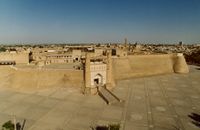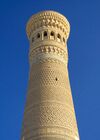أرك بخارى
39°46′40″N 64°24′39″E / 39.777832°N 64.4108545°E
أرك (أي "الفـُلـْك"، The Ark) هو حصن هائل في مدينة بخارى، أوزبكستان، شـُيـِّد لأول مرة في القرن الخامس الميلادي. بالإضافة إلى كونه منشأة عسكرية، فقد شمل الفـُلك ما كان في الأساس بلدة استقر فيها مختلف البلاطات الملكية التي سيطرت على المنطقة المحيطة ببخارى، خلال معظم تاريخ القلعة. تم استخدام الفلك كحصن حتى سقط في يد روسيا في عام 1920. حالياً، تعتبر أطلال الفـُلك من المعالم السياحية والمتاحف المنزلية التي تغطي تاريخها.
. . . . . . . . . . . . . . . . . . . . . . . . . . . . . . . . . . . . . . . . . . . . . . . . . . . . . . . . . . . . . . . . . . . . . . . . . . . . . . . . . . . . . . . . . . . . . . . . . . . . . . . . . . . . . . . . . . . . . . . . . . . . . . . . . . . . . . . . . . . . . . . . . . . . . . . . . . . . . . . . . . . . . . . .
وصف
الأصل الأسطوري
In legend, the creator of the Ark was the epic hero Siyavusha. As a youth, he hid in the rich oasis country of Turana from his stepmother. Siyavusha and the daughter of the local ruler of Afrosiaba fell in love. The girl's father agreed to permit them to marry provided that Siyavusha would first build a palace on the area bounded by a bull skin, obviously intended as an impossible task. But Siyavusha cut the bull skin into slender strips, connected the ends, and inside this boundary built the palace. (This is essentially the classical legend of Dido and the founding of Carthage in North Africa, as recorded in antiquity.)
التاريح
The Ark is built on the remains of earlier structures, which constitute a layer twenty meters deep under the base arch, the layers indicating that previous fortresses had been built and destroyed on the site.
The first known reference to the Ark is contained in the "History of Bukhara" by Narshakhi (899 - 960). Abubakra wrote "Bindu, the ruler of Bukhara, built this fortress, but it soon was destroyed. Many times it was constructed, many times destroyed." Abubakra says that when the last ruler to rebuild asked counsel of his wise men, they advised him to construct the fortress around seven points, located in the same relation to each other as the stars of the constellation Ursa Major. Thus built, the fortress was never again destroyed.[1]
The age of the Ark has not been established accurately, but by 500 AD it was already the residence of local rulers. Here, in the fastness of the citadel, lived the emirs, their chief viziers, military leaders, and numerous servants.
When the soldiers of Genghis Khan took Bukhara, the inhabitants of the city found refuge in the Ark, but the conquerors smashed the defenders and ransacked the fortress.
في العصور الوسطى، عمل على تشييد الحصن الرودكي والفردوسي وابن سينا والفارابي، ولاحقاً عمر الخيام. كما ضم الحصن مكتبة عظيمة، كتب عنها ابن سينا:
I found in this library such books, about which I had not known and which I had never before seen in my life. I read them, and I came to know each scientist and each science. Before me lay gates of inspiration into great depths of knowledge which I had not surmised to exist.
Most probably, the library was destroyed following one of the conquests of Bukhara.
During the Russian Civil War, the Ark was greatly damaged by Red Army troops under the command of Mikhail Frunze during the 1920 Battle of Bukhara. Frunze ordered the Ark bombed by aircraft, which left a large part of the structure in ruins. There is also reason to believe that the last Emir, Alim Khan (1880–1944), who escaped to Afghanistan with the royal treasury, ordered the Ark to be blown up so that its secret places (especially the harem) could not be desecrated by the Bolsheviks.
المصادر
- ^ "Archived copy". Archived from the original on 2017-12-01. Retrieved 2015-07-16.
{{cite web}}: CS1 maint: archived copy as title (link)
- Bissell, Tom. Chasing the Sea: Lost Among the Ghosts of Empire in Central Asia. Vintage Departures, 2004.
- Thubron, Colin. The Lost Heart of Asia. New York: HarperPerennial, 2001.







